How to grow tomatoes in containers or ground successfully with an enormous harvest and big-sized tomatoes? Let’s look into 10 really smart scientific tips, tricks, and hacks to successfully grow healthy tomato plants to yield tons of tomatoes. In the end, a scientifically proven bonus tomato hack that acts as an immune booster to tomato plants.
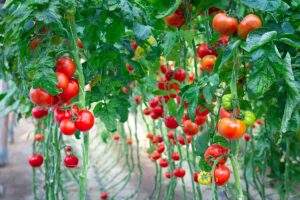
Tomatoes are usually the first veggie many newbie gardeners grow from seeds. To improve your success and achieve a healthy harvest, let’s learn these 10 tips on growing tomatoes starting from the seedling tips till the harvesting stage. These tips apply to any variety of tomatoes you grow, whether determinate or indeterminate types.
TOMATO SEED PLANTING TIPS
The furry coating on tomato seeds softens and gummies when water is added, which helps the seeds stick in place among soil particles. The seed coats also release chemicals into the soil that enhance growing conditions for the soon-to-come roots.
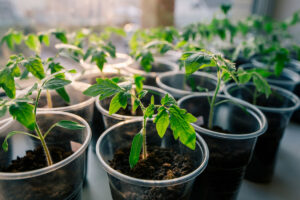
TOMATO TRANSPLANT TRICK
Technically speaking, yes, you can transplant tomato plants with fruit or flowers. As long as the plants aren’t severely root-bound in their pots, they’re quite hardy and should recover easily from any transplant shock (whether in a pot or in the ground).
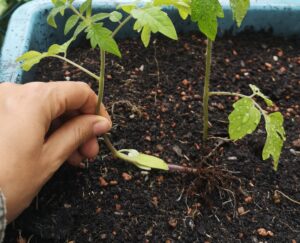
If your young plants are already loaded with blossoms, however, they stand a better chance of surviving a transplant if you remove all the flowers and fruit first.
This may sound counterintuitive, but a young plant that’s already flowering and fruiting is responding to stress. It’s putting all of its energy into producing seeds so it can spawn the next generation of tomato plants. This means it focuses more on producing tomatoes and less on growing new branches and leaves.
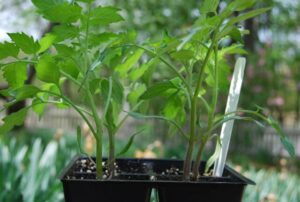
Letting a young plant flower and fruit in this early stage could stunt its growth or delay the production of more fruits. By pinching off the flowers before you transplant, you help it focus on vegetative growth so it can photosynthesize and grow strong and tall before it starts to flower abundantly.
TOMATO STAKING (SUPPORT)
The main reason for staking and supporting tomato plants is to keep plants and fruit off the ground. This reduces losses from fruit rots when fruit touches the soil and from sunburn when fruit are not shaded by foliage.
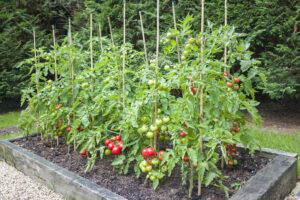
Supported plants are easier to spray or dust for insect and disease control and easier to harvest than those sprawling on the ground. Three popular methods of supporting tomato plants are staking, caging, and trellising.
Supported tomato plants are pruned (suckered) to reduce the number of branches, thereby making plants more suitable for the selected method of support. Plant type also determines the amount of pruning. Tomato varieties are divided into two general groups based on their pattern of growth.

TOMATO SUCKERS & PRUNING
It’s a question I’m asked all the time, “Should I remove tomato plant suckers?” The answer: “It depends!” There really isn’t a right or wrong answer to this question as it relies on a few factors like the type of tomato plants you’re growing and how you’re supporting them. Read on to learn whether or not you should pinch out tomato suckers.
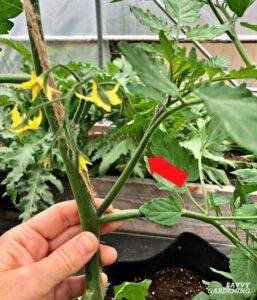
TOMATO SUNLIGHT REQUIREMENT
Growing healthy tomato plants takes plenty of sunlight. Plants need a minimum of six hours of direct sunlight.
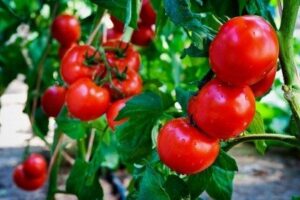
The plant converts the sunlight to energy, which it then uses to produce strong plants and abundant fruit. If you don’t have an area in your yard that gets this much sunlight each day, there are a few things you can do to enhance the light that is available.
You can easily grow tomatoes from seeds or tomatoes from tomatoes. You can plant seeds in small pots or seed trays.
Once they germinate and grow into little ones, you can choose the best ones and transplant them to small 4 to 6-inch pots and discard the weaker seedlings – that’s called thinning of seedlings.
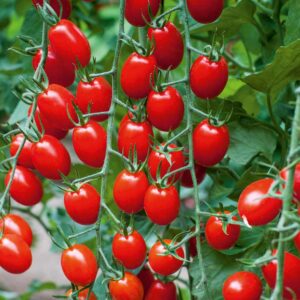
The tricks shown in the video will form a robust root system which in turn will produce a high-yielding, disease-resistant tomato plant. Generally, pruning of the lower branches is also recommended, especially for the indeterminate variety of tomato plants.
But I recommend this even for determinate varieties. Tomatoes love to be in full direct sunlight for at least 6-8 hours of continuous sun. So, whether you are growing on the ground or in containers, you have to choose a location that receives the maximum amount of sunlight.
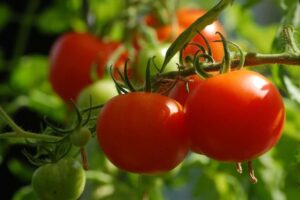
Tomatoes love to be in moist soil right from the seedling stage. As a general rule, you may have to water them daily, and depending on the temperature you may have to water them even twice.
The Blossom End Rot problem seen in tomatoes is due to calcium deficiency mainly due to this transportation issue and may not be due to soil deficiency of calcium. So proper watering is very important to prevent the blossom end rot issue which is an irreversible process.
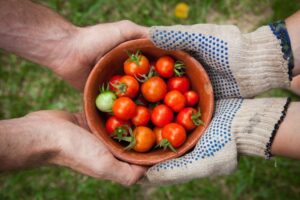
PLEASE WATCH THE VIDEO BElOW:
